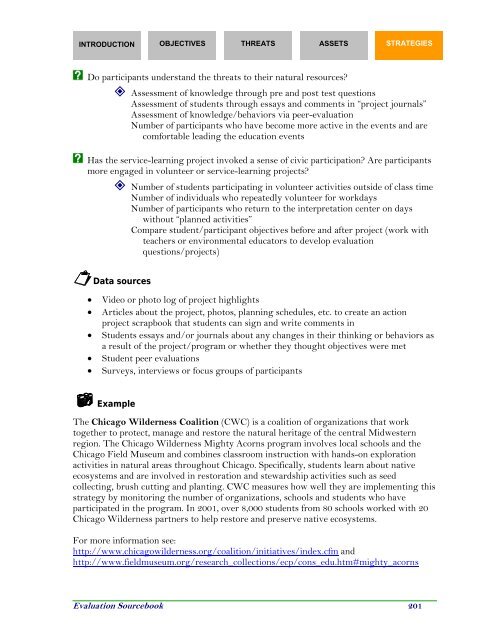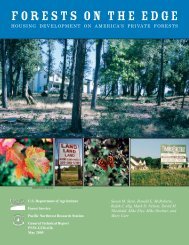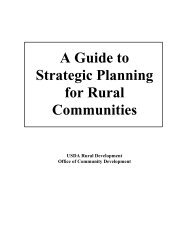Evaluation Sourcebook (.pdf) - School of Natural Resources and ...
Evaluation Sourcebook (.pdf) - School of Natural Resources and ...
Evaluation Sourcebook (.pdf) - School of Natural Resources and ...
- No tags were found...
You also want an ePaper? Increase the reach of your titles
YUMPU automatically turns print PDFs into web optimized ePapers that Google loves.
INTRODUCTION OBJECTIVES THREATS ASSETS STRATEGIESX Do participants underst<strong>and</strong> the threats to their natural resources? Assessment <strong>of</strong> knowledge through pre <strong>and</strong> post test questionsAssessment <strong>of</strong> students through essays <strong>and</strong> comments in “project journals”Assessment <strong>of</strong> knowledge/behaviors via peer-evaluationNumber <strong>of</strong> participants who have become more active in the events <strong>and</strong> arecomfortable leading the education eventsX Has the service-learning project invoked a sense <strong>of</strong> civic participation? Are participantsmore engaged in volunteer or service-learning projects? Number <strong>of</strong> students participating in volunteer activities outside <strong>of</strong> class timeNumber <strong>of</strong> individuals who repeatedly volunteer for workdaysNumber <strong>of</strong> participants who return to the interpretation center on dayswithout “planned activities”Compare student/participant objectives before <strong>and</strong> after project (work withteachers or environmental educators to develop evaluationquestions/projects)Data sources• Video or photo log <strong>of</strong> project highlights• Articles about the project, photos, planning schedules, etc. to create an actionproject scrapbook that students can sign <strong>and</strong> write comments in• Students essays <strong>and</strong>/or journals about any changes in their thinking or behaviors asa result <strong>of</strong> the project/program or whether they thought objectives were met• Student peer evaluations• Surveys, interviews or focus groups <strong>of</strong> participantsExampleThe Chicago Wilderness Coalition (CWC) is a coalition <strong>of</strong> organizations that worktogether to protect, manage <strong>and</strong> restore the natural heritage <strong>of</strong> the central Midwesternregion. The Chicago Wilderness Mighty Acorns program involves local schools <strong>and</strong> theChicago Field Museum <strong>and</strong> combines classroom instruction with h<strong>and</strong>s-on explorationactivities in natural areas throughout Chicago. Specifically, students learn about nativeecosystems <strong>and</strong> are involved in restoration <strong>and</strong> stewardship activities such as seedcollecting, brush cutting <strong>and</strong> planting. CWC measures how well they are implementing thisstrategy by monitoring the number <strong>of</strong> organizations, schools <strong>and</strong> students who haveparticipated in the program. In 2001, over 8,000 students from 80 schools worked with 20Chicago Wilderness partners to help restore <strong>and</strong> preserve native ecosystems.For more information see:http://www.chicagowilderness.org/coalition/initiatives/index.cfm <strong>and</strong>http://www.fieldmuseum.org/research_collections/ecp/cons_edu.htm#mighty_acorns<strong>Evaluation</strong> <strong>Sourcebook</strong> 201






